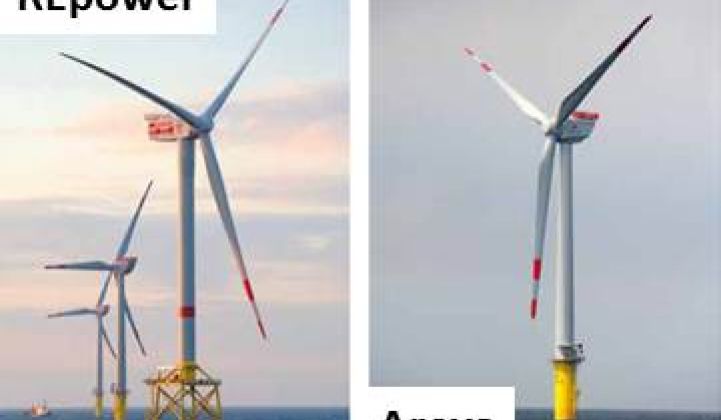If Germany’s fateful decision to phase out its nuclear program by 2022 is to be successful, it will require a massive buildup of offshore wind capacity. Skeptics say it can’t be done and believe the decision will result in more coal consumption, the purchase of French nuclear power and higher electricity bills for German consumers.
A recent German government agency paper said offshore wind will meet the country’s needs in the planned timeframe. If it does, it will in large part be thanks to Research at Alpha Ventus (RAVE), a public-private research program that has been an integral part of Alpha Ventus, the world’s first deep water ocean wind project off Germany’s North Sea coast, since planning began in 2006.
By the end of 2009, Alpha Ventus’ 12 five-megawatt turbines were generating electricity and undergoing thoroughly documented trials. The project was formally inaugurated last summer. That timeline contrasts dramatically with Cape Wind, the leading U.S. deep water project.
After nine years of struggle and controversy, Cape Wind may see building begin next year and may have its planned 420-megawatt capacity fully installed by 2014 or 2015 -- at a cost of $2.6 billion because of its long, expensive permitting process. Cape Wind has taught the U.S. offshore wind industry little other than that onshore wind is cheaper and less fraught with difficulties.
World offshore wind capacity is expected to go from its present four gigawatts to over 70 gigawatts before 2020. Europe expects to obtain seventeen percent of its electricity from offshore wind by 2030. While there are proposals for U.S. projects in the Gulf of Mexico, the Great Lakes and off Rhode Island, New Jersey, Delaware and Maryland on the Atlantic coast, there is as yet no construction, just permitting hassles.
Meanwhile, RAVE research has produced conclusions about best practices in short-term studies, and RAVE’s scientists, who hail from dozens of institutions and companies, are assimilating substantial data in longer-term studies with results due in 2012.
“RAVE is the main project,” said David Schlipf, a researcher who holds the Endowed Chair of Wind Energy at the University of Stuttgart. Operated under the auspices of Germany’s Federal Ministry for the Environment (BMU), Schlipf explained, the research initiative is funded partly by taxpayers and partly by utility and energy industry interests. It is composed, he said, of a full spectrum of research.
The degree of organization is impressive. There are projects for foundations and support structures; turbine technologies (including components, blades, wind and output measurement, and maintenance); grid integration (including transmission, forecasting and energy markets); and environmental factors (including ecological impacts, noise, public acceptance, and geology and oceanography). All data, both public and proprietary, is carefully overseen.
An early RAVE result from Schlipf’s own research into light detection and ranging (LIDAR) technology, a cutting-edge use of lasers to map anticipated wind speed and direction, showed that LIDAR can economically predict when winds will be damaging and allow intervention that, Schlipf said, will significantly reduce the cost of turbine maintenance.
The centerpieces of RAVE’s comprehensive research are an Areva Multibrid M5000 5-megawatt turbine and a comparable REpower 5M turbine, paired for study. Two major points of intentionally selected differentiation, Schlipf pointed out, are that the Areva turbine incorporates permanent magnet direct drive technology, whereas the REpower turbine has a traditional gearbox, and that the Areva is mounted on a tripod foundation while the REpower is mounted on a jacket foundation.
Though Siemens, Sinovel and other manufacturers now have experimental 6-megawatt prototypes operating, the RAVE findings are nevertheless likely to be highly determinative for offshore project developers when the final reports are issued in 2012.
By then, Germany, the U.K. and China will be gearing up for major offshore development. They will all be looking to deep waters where, Schlipf said, “you have the benefit of stronger winds that create about a 40-percent capacity factor.” The main drawback, he added, is the need for more frequent and more expensive maintenance. But “offshore wind will be price competitive soon,” he noted. “There will be cost reductions by reducing the load and improving control,” he said. “But I think the main price driver will be scale.”
As in the U.S., transmission is an issue for Germany. “The wind is in the north,” Schlipf said, “and the major cities are in the south.” As in the U.S., he said, infrastructure build-out is needed. Unlike the U.S., present plans will, Schlipf said, make it possible “to have a stable grid but a renewable grid” despite the challenges of variability.
Of the cost for transmission, Schlipf said, “I think compared with all the money they are still spending with nuclear power plants and the money they have to spend to manage the waste, it’s nothing,” because “it’s not a matter of technical limitations.”
Other undertakings like RAVE are forming elsewhere. A U.K. project is developing a 10-megawatt turbine. A Spanish-led consortium is working on an almost-inconceivable 20-megawatt turbine. Even the U.S. Department of Energy is sponsoring research at the University of Maine and Clemson University, though it does not yet have a real turbine in the water.
Talking with Schlipf about RAVE was strange, because in the U.S. offshore wind is a controversy, not a reality. Schlipf and his RAVE colleagues and forward-thinking German leaders are making it happen. RAVE on.



